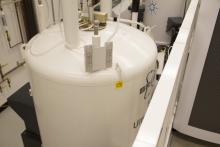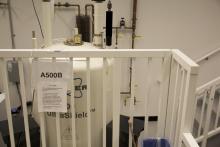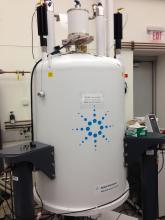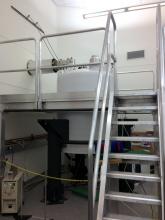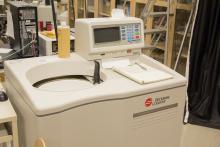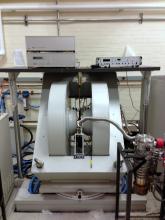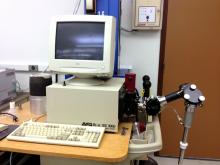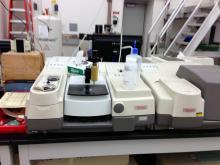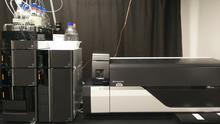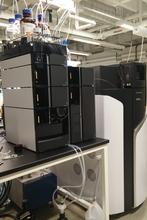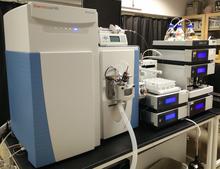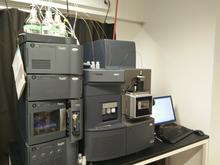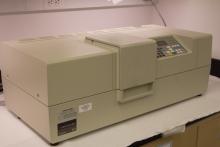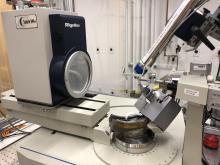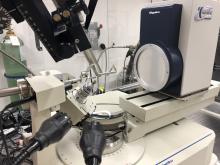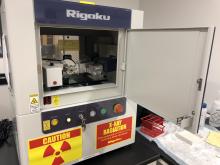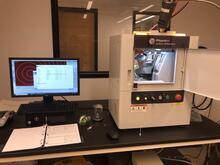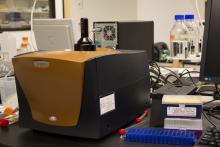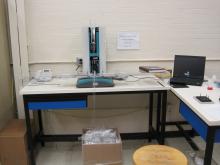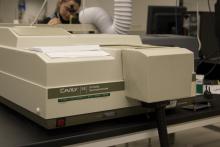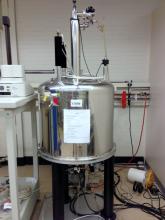Instrument Catalog
-
Staff mounted samples will be mounted at the convenience of their schedule.
-
Samples can be submitted on the table outside KCL 3
-
To independently use the single crystal diffractometers, you must meet one of the following subpoints:
-
Completed CHEM 511 and 512
-
Completed an equivalent course/training at a different institution with a recommendation from the instructor/instrument manager.
-
-
Independent access enables X-ray facility use for your own research.
-
Independent use does not enable facility use for you to collect data on behalf of other researchers at Yale.
-
Exceptions are granted on a case-by-case basis.
-
500 MHz wide-bore NMR spectrometer.
3.2 mm CPMAS probe normally installed for solid-state NMR experiments.
Micro MRI imaging capabilities
2 channel system with AS7620 96-sample changer. OneNMR
probe with auto-tune-and-match installed.
Undergraduates have priority on this instrument during lab periods.
Guides and Standard Operating Procedures
Best experiments:
- PROTON
- COSY
- Other nuclei: F19 (no H1 decoupling), P31, B11, (others by request)
Acceptable experiments:
- C13CPD (night time)
- 2D HSQC and HMBC experiments
- 1D/2D NOE experiments
Not available:
- Variable Temperature experiments
- Kinetics experiments
- Simultaneous F19 and H1 experiments
Time Required for NMR Experiments on A400a:
| Mass | Concentration | Proton | Carbon | gCOSY | gHSQC | gHMBC |
| 0.03 mg | 0.1 mM | 10 h 40 min | 35389 hours | 1785 hours | 1886 hours | 7129 hours |
| 0.06 mg | 0.2 mM | 2 h 40 min | 10516 hours | 46 h 28 min | 474 h 12 min | 1785 hours |
| 0.15 mg | 0.5 mM | 0 h 26 min | 1415 h 33 min | 6 h 10 min | 75 h 01 min | 284 h 44 min |
| 0.3 mg | 1 mM | 0 h 06 min | 354 h 01 min | 1 h 40 min | 18 h 53 min | 71 h 19 min |
| 0.6 mg | 2 mM | 0 h 01 min | 88 h 31 min | 0 h 26 min | 4 h 42 min | 17 h 51 min |
| 1.5 mg | 5 mM | < 1 min | 14 h 09 min | 0 h 03 min | 0 h 45 min | 2 h 51 min |
| 3 mg | 10 mM | < 1 min | 3 h 32 min | 0 h 03 min | 0 h 16 min | 1 h 07 min |
| 6 mg | 20 mM | < 1 min | 0 h 53 min | 0 h 03 min | 0 h 08 min | 0 h 17 min |
| 12 mg | 40 mM | < 1 min | 0 h 13 min | 0 h 03 min | 0 h 08 min | 0 h 17 min |
| 15 mg | 50 mM | < 1 min | 0 h 08 min | 0 h 03 min | 0 h 08 min | 0 h 17 min |
| > 30 mg | 100+ mM | < 1 min | 0 h 04 min | 0 h 03 min | 0 h 08 min | 0 h 17 min |
All estimates based on a 500 MW sample in 600 uL solvent volume using a 5 mm diameter NMR tube
2 channel system. AutoX DB probe installed. Variable-temperature and H/F experiments available.
Guides and Standard Operating Procedures
Best experiments:
- PROTON
- Simultaneous F19 and H1 experiments (i.e. F19 with H1 decoupling)
- Variable Temperature experiments (with appropriate CBIC training)
- Kinetics experiments
Acceptable experiments:
- C13CPD
- 2D HSQC and HMBC experiments
- 1D/2D NOE experiments
Not available:
- Nuclei other than H1, F19 & C13
Time Required for NMR Experiments on A400b:
| Mass | Concentration | Proton | Carbon | gCOSY | gHSQC | gHMBC |
| 0.03 mg | 0.1 mM | 44 h 44 min | 50960 hours | 644 hours | 7862 hours | 29844 hours |
| 0.06 mg | 0.2 mM | 11 h 11 min | 12740 hours | 161 hours | 1965 hours | 7461 hours |
| 0.15 mg | 0.5 mM | 1 h 47 min | 2038 h 24 min | 25 h 47 min | 319 h 18 min | 1193 h 57 min |
| 0.3 mg | 1 mM | 0 h 27 min | 509 h 36 min | 6 h 30 min | 78 h 37 min | 298 h 40 min |
| 0.6 mg | 2 mM | 0 h 07 min | 127 h 27 min | 1 h 38 min | 19 h 48 min | 75 h 40 min |
| 1.5 mg | 5 mM | 0 h 01 min | 20 h 23 min | 0 h 16 min | 3 h 08 min | 12 h 15 min |
| 3 mg | 10 mM | < 1 min | 5 h 15 min | 0 h 06 min | 0 h 47 min | 1 h 32 min |
| 6 mg | 20 mM | < 1 min | 1 h 16 min | 0 h 03 min | 0 h 08 min | 0 h 17 min |
| 12 mg | 40 mM | < 1 min | 0 h 19 min | 0 h 03 min | 0 h 08 min | 0 h 17 min |
| 15 mg | 50 mM | < 1 min | 0 h 12 min | 0 h 03 min | 0 h 08 min | 0 h 17 min |
| > 30 mg | 100+ mM | < 1 min | 0 h 04 min | 0 h 03 min | 0 h 08 min | 0 h 17 min |
All estimates based on a 500 MW sample in 600 uL solvent volume using a 5 mm diameter NMR tube
2 channel system with AS7620 96-sample changer. OneNMR probe with auto-tune-and-match installed.
Primarily used for short, routine NMR experiments where data is needed quickly.
Guides and Standard Operating Procedures
Best experiments:
- PROTON
- COSY
- Other nuclei: F19 (no H1 decoupling), P31, B11, (others by request)
Acceptable experiments:
- C13CPD (night time)
- 2D HSQC and HMBC experiments (night time)
- 1D/2D NOE experiments (night time)
Not available:
- Variable Temperature experiments
- Kinetics experiments
- Simultaneous F19 and H1 experiments
Time Required for NMR Experiments on A400c:
| Mass | Concentration | Proton | Carbon | gCOSY | gHSQC | gHMBC |
| 0.03 mg | 0.1 mM | 10 h 40 min | 35389 hours | 1785 hours | 1886 hours | 7129 hours |
| 0.06 mg | 0.2 mM | 2 h 40 min | 10516 hours | 46 h 28 min | 474 h 12 min | 1785 hours |
| 0.15 mg | 0.5 mM | 0 h 26 min | 1415 h 33 min | 6 h 10 min | 75 h 01 min | 284 h 44 min |
| 0.3 mg | 1 mM | 0 h 06 min | 354 h 01 min | 1 h 40 min | 18 h 53 min | 71 h 19 min |
| 0.6 mg | 2 mM | 0 h 01 min | 88 h 31 min | 0 h 26 min | 4 h 42 min | 17 h 51 min |
| 1.5 mg | 5 mM | < 1 min | 14 h 09 min | 0 h 03 min | 0 h 45 min | 2 h 51 min |
| 3 mg | 10 mM | < 1 min | 3 h 32 min | 0 h 03 min | 0 h 16 min | 1 h 07 min |
| 6 mg | 20 mM | < 1 min | 0 h 53 min | 0 h 03 min | 0 h 08 min | 0 h 17 min |
| 12 mg | 40 mM | < 1 min | 0 h 13 min | 0 h 03 min | 0 h 08 min | 0 h 17 min |
| 15 mg | 50 mM | < 1 min | 0 h 08 min | 0 h 03 min | 0 h 08 min | 0 h 17 min |
| > 30 mg | 100+ mM | < 1 min | 0 h 04 min | 0 h 03 min | 0 h 08 min | 0 h 17 min |
All estimates based on a 500 MW sample in 600 uL solvent volume using a 5 mm diameter NMR tube
2 channel system, OneNMR probe with auto-tune-and-match installed.
Guides and Standard Operating Procedures
Best experiments:
- PROTON
- COSY
- 2D HSQC and HMBC experiments
- 1D/2D NOE experiments
- Other nuclei: F19 (no H1 decoupling), P31, B11, (others by request)
- Variable Temperature experiments
- Kinetics experiments
Acceptable experiments:
- C13CPD
Not available:
- Simultaneous F19 and H1 experiments
Time Required for NMR Experiments on A500a:
| Mass | Concentration | Proton | Carbon | gCOSY | gHSQC | gHMBC |
| 0.03 mg | 0.1 mM | 5 hours | 16962 hours | 67 h 16 min | 820 h 42 min | 3113 h 37 min |
| 0.06 mg | 0.2 mM | 1 h 10 min | 424 h 02 min | 16 h 50 min | 205 h 15 min | 779 h 06 min |
| 0.15 mg | 0.5 mM | 0 h 11 min | 678 h 28 min | 2 h 45 min | 32 h 50 min | 124 h 34 min |
| 0.3 mg | 1 mM | 0 h 03 min | 170 h 00 min | 0 h 42 min | 8 h 20 min | 31 h 09 min |
| 0.6 mg | 2 mM | < 1 min | 4 h 15 min | 0 h 11 min | 2 h 05 min | 7 h 48 min |
| 1.5 mg | 5 mM | < 1 min | 3 h 11 min | 0 h 03 min | 0 h 08 min | 1 h 40 min |
| 3 mg | 10 mM | < 1 min | 1 h 42 min | 0 h 03 min | 0 h 08 min | 0 h 17 min |
| 6 mg | 20 mM | < 1 min | 0 h 25 min | 0 h 03 min | 0 h 08 min | 0 h 17 min |
| 12 mg | 40 mM | < 1 min | 0 h 06 min | 0 h 03 min | 0 h 08 min | 0 h 17 min |
| 15 mg | 50 mM | < 1 min | 0 h 04 min | 0 h 03 min | 0 h 08 min | 0 h 17 min |
| > 30 mg | 100+ mM | < 1 min | 0 h 04 min | 0 h 03 min | 0 h 08 min | 0 h 17 min |
All estimates based on a 500 MW sample in 600 uL solvent volume using a 5 mm diameter NMR tube
2 channel system, OneNMR probe with auto-tune-and-match installed.
Guides and Standard Operating Procedures
Best experiments:
- PROTON
- COSY
- 2D HSQC and HMBC experiments
- 1D/2D NOE experiments
- Other nuclei: F19 (no H1 decoupling), P31, B11, (others by request)
- Variable Temperature experiments
- Kinetics experiments
Acceptable experiments:
- C13CPD
Not available:
- Simultaneous F19 and H1 experiments
Time Required for NMR Experiments on A500b:
| Mass | Concentration | Proton | Carbon | gCOSY | gHSQC | gHMBC |
| 0.03 mg | 0.1 mM | 5 hours | 16962 hours | 67 h 16 min | 820 h 42 min | 3113 h 37 min |
| 0.06 mg | 0.2 mM | 1 h 10 min | 424 h 02 min | 16 h 50 min | 205 h 15 min | 779 h 06 min |
| 0.15 mg | 0.5 mM | 0 h 11 min | 678 h 28 min | 2 h 45 min | 32 h 50 min | 124 h 34 min |
| 0.3 mg | 1 mM | 0 h 03 min | 170 h 00 min | 0 h 42 min | 8 h 20 min | 31 h 09 min |
| 0.6 mg | 2 mM | < 1 min | 4 h 15 min | 0 h 11 min | 2 h 05 min | 7 h 48 min |
| 1.5 mg | 5 mM | < 1 min | 3 h 11 min | 0 h 03 min | 0 h 08 min | 1 h 40 min |
| 3 mg | 10 mM | < 1 min | 1 h 42 min | 0 h 03 min | 0 h 08 min | 0 h 17 min |
| 6 mg | 20 mM | < 1 min | 0 h 25 min | 0 h 03 min | 0 h 08 min | 0 h 17 min |
| 12 mg | 40 mM | < 1 min | 0 h 06 min | 0 h 03 min | 0 h 08 min | 0 h 17 min |
| 15 mg | 50 mM | < 1 min | 0 h 04 min | 0 h 03 min | 0 h 08 min | 0 h 17 min |
| > 30 mg | 100+ mM | < 1 min | 0 h 04 min | 0 h 03 min | 0 h 08 min | 0 h 17 min |
All estimates based on a 500 MW sample in 600 uL solvent volume using a 5 mm diameter NMR tube
3 channel system with AS7510 12-sample automatic sample changer. C{H} cold probe with auto-tune-and-match installed. Highest sensitivity for C13 NMR experiments.
Guides and Standard Operating Procedures
Best experiments:
- CARBON
- PROTON
Acceptable experiments:
- 1D/2D NOE experiments
Not available:
- Variable Temperature experiments
- Kinetics experiments
- Nuclei other than H1 and C13
Time Required for NMR Experiments on A600a:
| Mass | Concentration | Proton | Carbon | gCOSY | gHSQC | gHMBC |
| 0.03 mg | 0.1 mM | 0 h 24 min | 1298 hours | 5 h 54 min | 72 h 04 min | 272 h 22 min |
| 0.06 mg | 0.2 mM | 0 h 06 min | 324 h 32 min | 1 h 28 min | 19 h 35 min | 68 h 32 min |
| 0.15 mg | 0.5 mM | 0 h 01 min | 51 h 56 min | 0 h 16 min | 3 h 11 min | 11 h 10 min |
| 0.3 mg | 1 mM | < 1 min | 13 h 00 min | 0 h 03 min | 0 h 47 min | 2 h 47 min |
| 0.6 mg | 2 mM | < 1 min | 3 h 15 min | 0 h 03 min | 0 h 16 min | 1 h 07 min |
| 1.5 mg | 5 mM | < 1 min | 0 h 31 min | 0 h 03 min | 0 h 08 min | 0 h 34 min |
| 3 mg | 10 mM | < 1 min | 0 h 08 min | 0 h 03 min | 0 h 08 min | 0 h 17 min |
| 6 mg | 20 mM | < 1 min | 0 h 04 min | 0 h 03 min | 0 h 08 min | 0 h 17 min |
| 12 mg | 40 mM | < 1 min | 0 h 04 min | 0 h 03 min | 0 h 08 min | 0 h 17 min |
| 15 mg | 50 mM | < 1 min | 0 h 04 min | 0 h 03 min | 0 h 08 min | 0 h 17 min |
| > 30 mg | 100+ mM | < 1 min | 0 h 04 min | 0 h 03 min | 0 h 08 min | 0 h 17 min |
All estimates based on a 500 MW sample in 600 uL solvent volume using a 5 mm diameter NMR tube
4 channel system. Inverse-detect HCN probe, Dual Band (direct-detect) probe, and H{CN} C13-sensitivity enhanced salt-tolerant cold probe available.
Experienced Users Only. Contact CBIC staff for more information.
Analytical ultracentrifugation is a column-free separation technique that measures the relative change in the distribution of molecular weights, providing a way to measure heterogeneity, stoichiometry and self-association of proteins, oligomers, aggregates, particles, colloids, and small structures in solution.
Chirascan is a modern, high performance circular dichroism (CD) spectrometer operating in the ultraviolet and visible wavelength range. It is typically used to probe the secondary structure or conformation of bio-molecules.
Dynamic light scattering measures the diffusion rate of molecules or particles in solution by observing the fluctuations in scattered light from a laser passing through a sample. The sensitivity of DLS increases with increasing molecular size, with a typical lower size limit of 0.5 nanometers and upper size limit of 10 micrometers.
Typical applications for DLS include:
- Screening macromolecules prior to crystallization trials
- Measuring the stability of protein samples for NMR analysis
- Monitoring molecular aggregation
- Characterizing nanoparticles
The DynaPro PlateReader II is set up to make these measurements in 96, 384, or 1536 well plates using as little as 5 microliters of sample.
X-Band Electron Paramagnetic Resonance. Equipped with a cryogen-free cryostat.
React IR 15 FTIR for real-time monitoring of chemical reactions in situ.
The IRTracer-100 offers exceptionally high sensitivity with an SN ratio of 60,000:1, high resolution down to 0.25 cm−1, and fast measurement speeds up to 20 scans per second.
The system supports a wide variety of applications with features such as a 12,000-entry library and a data analysis program for contaminant analysis and time course and rapid scan functions for tracking reactions.
Available Accessories:
- ATR Unit for Solid Samples
- VeeMax II Variable Angle Specular Reflectance Accessory
- Gas Cuvette & Holder
- KBr Pellets
For more compatible accessories for your measurement needs, please have a look at the Shimadzu Selection Guide.
Diamond ATR cell normally installed. Transmission, DRIFTS, ZnSe ATR, and high-temperature accessories available. Raman with IR-laser source also available.
Open access GC-MS instrument with 100-position sample changer and 20 meter column installed.
| Column Name | Manufacturer | Thickness (um) | Length (m) | Diameter (mm) | Max. Temp. (deg C) |
| SH-Rxi-5Sil MS | Shimadzu | 0.25 | 30 | 0.25 | 350 |
| DB select 624UI | Agilent | 1.4 | 30 | 0.25 | 260 |
| ZB-WAX | Zebron | 0.5 | 30 | 0.25 | 250 |
| PoraPLOT Q | Agilent | 8 | 25 | 0.25 | 250 |
| EC-1 | Grace | 0.25 | 30 | 0.25 | 350 |
| VF-WAXms | Agilent | 1 | 30 | 0.25 | 260 |
| Rtx-1 | Restek | 0.25 | 15 | 0.25 | 350 |
| Stabilwax-MS | Restek | 0.25 | 30 | 0.25 | 260 |
Shimadzu 8050 NX Triple Quadrupole (TQ) GC-MS with Liquid Injection, Solid Phase Micro Extraction (SPME) and Headspace Analysis Autosampler. Triple Quadrupole MS instruments allow for quantitation of compounds, collision induced dissociation (CID) and multiple reaction monitoring (MRM). The system is equipped with an Electron Ionization (EI) source, a Chemical Ionization (CI) source and a Flame Ionization Detector (FID).
Service only Shimadzu LCMS-8060 Triple Quadrupole Liquid Chromatograph Mass Spectrometer (LC-MS/MS). Triple Quadrupole MS instruments allow for quantitation of compounds, collision induced dissociation (CID) and multiple reaction monitoring (MRM) with high sensitivity. The UPLC system includs a fluidic system with two different solvents, three trays for up to 54 samples each (in GC vials), three UPLC columns (see list below) and a photo-diode array (UV/Vis) detector. 96 and 384 well plates can be used for screening projects, please reach out first.
Column 1: Shim-pack Scepter C18-120 1.9mum - 2.1 x 50mm
Column 2: Shim-pack Scepter C18-120 1.9mum - 2.1 x 100mm
Column 3: Shim-pack Scepter C8-120 1.9mum - 2.1 x 100mm
Different columns can be installed on demand.
Standard Solvents available for LC separation:
Water (with 0.1% Formic Acid or 10mM NH4Ac)
Methanol (with and w/o 0.1% Formic Acid or 10mM NH4Ac)
Acetonitrile (with and w/o 0.1% Formic Acid or 10mM NH4Ac)
Different solvents can be used on demand.
Shimadzu LCMS-9030 Quadrupole Time-of-Flight High-Performance Liquid Chromatograph Mass Spectrometer for high-resolution MS.
Service only high resolution Q-tof MS instrument with an UPLC system, including a fluidic system with two different solvents, three trays for up to 54 samples each (in GC vials), three UPLC columns (see list below) and a photo-diode array (UV/Vis) detector. 96 and 384 well plates can be used for screening projects, please reach out first.
Column 1: Shim-pack Scepter C18-120 1.9mum - 2.1 x 50mm
Column 2: Shim-pack Scepter C18-120 1.9mum - 2.1 x 100mm
Column 3: Shim-pack Scepter C8-120 1.9mum - 2.1 x 100mm
Different columns can be installed on demand.
Standard Solvents available for LC separation:
- Water (with 0.1% Formic Acid or 10mM NH4Ac)
- Methanol (with and w/o 0.1% Formic Acid or 10mM NH4Ac)
- Acetonitrile (with and w/o 0.1% Formic Acid or 10mM NH4Ac)
Different solvents can be used on demand.
Service only high resolution QExactive Orbitrap FT-MS instrument with an Dionex 3000 UPLC system, including a fluidic system with up to four different solvents, three trays for up to 40 samples each (in 2 mL GC vials), one UPLC column, a UV/Vis photo-diode array (PDA) and a fluorescence (FL) detector.
The structural mass spectrometry extension on this instrument allows for recording of infrared spectra of mass selected ions in the gas phase. Read more about the technique here.
Software for opening and converting .raw files: http://msfragger.nesvilab.org/tutorial_convert.html
Service only high resolution Q-tof MS instrument with an UPLC system, including a fluidic system with up to four different solvents, two trays for up to 48 samples each (in GC vials), four UPLC columns (see list below) and a photo-diode array (UV/Vis).
Column 1: Acquity UPLC BEH C18 1.7mum - 2.1 x 50mm
Column 2: Acquity UPLC BEH Glycan 1.7mum - 2.1 x 100mm
Column 3: Acquity UPLC BEH300 C18 1.7mum - 2.1 x 100mm
Column 4: Acquity UPLC BEH C8 1.7mum - 2.1 x 100mm
AXIMA Confidence Linear/Reflectron MALDI-TOF Mass Spectrometer from Shimadzu.
Target Plates available:
AXIMA 384 well (2.8mm I.D.) plate - P/N: DE1580TA
| Number of wells: | Sample = 384 Calibrant = 0 |
| Internal diameter of wells: | Sample = 2.8mm Calibrant = N/A |
FlexiMass-SR48 steel targets - P/N: TO-431R00
| Number of wells: | Sample = 48 Calibrant = 3 |
| Internal diameter of wells: | Sample = 2.8mm Calibrant = 2.2mm |
FlexiMass-DS disposable targets - P/N: TO-430R00
| Number of wells: | Sample = 48 Calibrant = 3 |
| Internal diameter of wells: | Sample = 2.8mm Calibrant = 1.5mm |
Mass Spectrometry meets Infrared Spectroscopy
Structural insights into cold, mass selected ions
https://cbic.yale.edu/mass-spectrometry-meets-infrared-spectroscopy
Disclaimer: All information on this site is subject to change and the actual experimental methods used might differ from the ones found here!
Recommendations:
MS_Sample_Method_Recommendations_v2.docx
Method Descriptions (methods might have changed over time, please double-check!):
Shimadzu 9030 HRMS Description
Thermo Fisher QExactive Orbitrap HRMS Description
Software:
Data exchange
MS data can be exported as mzXML or mzML files and shared via box or google drive upon request. The files contain TIC and MS data, EIC can be extracted through user analysis. These data files can be opened with MestreNova (updated and fully installed licenses necessary!):
Download the software and license bundle from the CBIC homepage:
https://cbic.yale.edu/yale-only/mnova-download
Close MestreNova (for update of existing installation), and run as Administrator by:
Windows Start menu -> MestreNova Folder -> Right Click on MestreNova -> more -> Run as Administrator
Install the Licenses again, close the software and start it as a normal user.
Complex data workups and simple txt data can be provided based on the project.
Software for opening and converting ThermoFisher .raw files: http://msfragger.nesvilab.org/tutorial_convert.html
Acknowledgements:
If you use CBIC instruments in your research, we request that you acknowledge our facility in your written publications or grant applications as follows:
Acknowledgement: This research made use of the Chemical and Biophysical Instrumentation Center at Yale University. Equipment was purchased with funds from Yale University and the NSF MRI grant CHE-1828190.
The Pilatus3R 200KA detector on our Rigaku 007 HF+ rotating anode with VHF Arc)Sec optics is suitable for solving small molecules samples. This instrument is run by the CBIC Staff. λ = 0.7107 Å
General-purpose precision Polarimeter with Na and Hg source lamps and Glan-Taylor polarizer.
The AUTOPOL® IV is a microprocessor based automatic polarimeter that is available in one, two and six wavelength versions. The AUTOPOL® IV’s features include: readout in Specific Rotation, Optical Rotation, and concentration, customer defined and labeled programs for push button readout, large LCD display and touchscreen user interface, temperature display and correction, push button wavelength selection, statistics, 3 USB ports, 1-USB 3.0, RS 232 and parallel printer ports.
The Saturn 944+ CCD detector on our Rigaku 007 HF+ rotating anode X-ray source with HF optics is suitable for solving small-molecule and protein structures by single-crystal X-ray diffraction. This instrument can also be used to screen crystals before sending them to an x-ray beam line at a synchrotron. λ = 1.5418 Å
The Rigaku Saturn 944HG CCD detector on our Rigaku 007 HF+ rotating anode X-ray source with HF Arc)Sec optics is suitable for solving small molecules samples. This instrument is run by the CBIC Staff. λ = 1.5418 Å
This powder diffractometer can characterize crystallinity, crystal phases, and, in many cases, the identity of solid samples. Our instrument has a sealed-tube copper X-ray source, a scintillation counter with high dynamic range, and Bragg-Brentano geometry with slits providing high resolution for flat powder samples. λ = 1.5418 Å
The XtaLabMini II is a fully functional benchtop single-crystal X-ray diffractometer with a CCD detector. λ = 0.7107 Å
Copper and silver X-ray sources are available. The curved image plate detector allows high dynamic range and collection out to a 2Θ angle of 144 degrees in a single image to yield high-resolution single-crystal data.
By determining heat changes associated with binding between any two biomolecules, ITC measures all binding parameters in a single label-free, in-solution experiment.
The Fluorolog 3 is a modular fluorimeter that can be set up to make time-domain fluorescence measurements at specific wavelengths, or steady-state fluorescence measurements over a range of excitation and/or emission wavelengths.
TTP Labtech’s mosquito allows for the creation of protein crystallization screens with several multi-component drops per well, even in 96-well hanging drop set-ups.
Standard cuvette holder, temperature-regulated cuvette sample change, and integrating sphere available.
High performance UV-VIS-NIR Spectrophotometer with four gratings, wide dynamic range -6 to 6.0 ABS, resolution to 0.1nm, excellent stray light rejection: less than 0.00008% at 220nm, sealed optics, self-aligning lamps, high-mass, stable optical bench, selectable and constant bandpass.
Options:
- Integrating sphere for solid and liquid samples with 3 detector system includes - PMT, InGaAs and Peltier controlled PbS detectors for a superior S/N ratio.
- S-1700 Thermoelectric Single Cell Holder Temperature Controller (0 to 110 deg C) with stirrer, Thermal Melt Software for analysis of e.g. DNA melting temperatures.
3 channel system. Inverse-detect HCN probe installed.
3 channel system. Inverse-detect HCN probe installed.
4 channel system, triple resonance probe normally installed.
The Xeuss 3.0 offers a maximum flexibility of measurement configurations to get the best possible data quality on any type of sample.
In particular, the following key features enable the user to optimize experiments or results:
- High flux settings adapted for fast kinetics embedded in a low background camera
- Largest surface of detection moveable all the way from WAXS to long distance SAXS to optimize resolution and signal-to-noise
- Long distance SAXS settings for measuring large characteristic dimensions (up to 900 nm depending on the Xeuss 3.0 model)
- Optional USAXS module to characterize large structures ( > 2.5 µm)
Micro-CT is a 3D imaging technique utilizing X-rays to see inside an object, slice by slice. Micro-CT, also called microtomography or micro computed tomography, is similar to hospital CT or “CAT” scan imaging but on a small scale with greatly increased resolution. Samples can be imaged with pixel sizes as small as ~1 micron and objects can be scanned up to ~50 cm in diameter.
The versatile XT H 225 scanner can be used to cover a wide range of applications, including the inspection of plastic parts, electronics and complex mechanisms as well as researching materials and natural specimens.
The scanner can be fit with a rotating anode, reflection, or transmission target. The rotating anode produces the most X-rays, which is good for highly absorbing material, but has the lowest resolution. The transmission target has the best resolution, but produces the least amount of X-rays. The reflection target is typically installed and has a balance between X-ray intensity and resolution. If your needs require the rotating or transmission target, please inquire in advance about scheduling.


